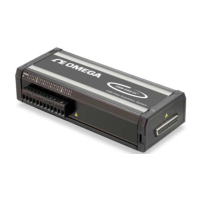• The pre-trigger scan count specifies the number of scans that are to be collected before the trigger
point. If the pre-trigger scan count is greater than zero, the system will continuously collect data
until the trigger is satisfied. If no pre-trigger scans are required, the system sits idle until the trigger;
then, it collects the post-trigger scans before it disarms.
• The post-trigger scan count specifies the number of scans to be collected after the trigger point.
After the trigger, the post-trigger scans will be collected as programmed and then the system will
disarm itself.
• The trigger source can be a software command, an external TTL input, etc. An analog input
channel on reaching a specified voltage level can be used to trigger the system.
Input Isolation
Three benefits of input isolation are circuit protection, noise reduction, and the rejection of high common
mode voltage.
• Circuit protection. Input isolation separates the signal source from circuits that may be damaged by
the signal. (Voltages higher than about 10 V can distort data or damage chips used in data
acquisition.) High-voltage signals or signals with high-voltage spikes should therefore be isolated.
The protection can also work the other way—to safeguard a sensitive signal conditioner from a
failing device elsewhere in the system.
• Noise reduction. Isolation eliminates ground loops for high-gain systems and multi-unit systems
that are grounded together. The chassis for each device can rest at a ground potential slightly
different from the other devices. These irrelevant currents and the spikes they may have picked up
by induction can thus be kept out of the measurement circuit.
• Rejection of high common mode voltage. There is a limit to the amount of voltage a differential
amplifier can have applied between ground and the amplifier inputs. Fortunately, the differential
amplifier rejects high common mode voltage signals. High common mode voltage and noise spikes
are rejected (canceled out) in in-phase signals identical in amplitude and frequency that are present
in both the high and low inputs at the same time.
Signal Modes
Personal Daq units operate in one of two modes, (1) single-ended mode, or (2) differential mode. These
terms (single-ended mode and differential mode) apply to their use in this manual. In other sources these
terms may be used in a different manner.
Choosing between differential and single-ended inputs is made by software command. The following text
briefly describes the two signal modes.
Single-ended mode refers to a mode, or circuit set-up, in which a voltage is measured between 1 signal line
and common ground voltage (Vcm). The measured voltage may be shared with other channels. The
advantage of a single-ended non-differential mode [over differential mode] is that it provides for a higher
channel count, for example: 20 channels instead of 10.
In Personal Daq applications, thermocouples should not be connected single-ended. Doing
so can result in noise and false readings. This is especially true when acquiring other high-
amplitude signals in conjunction with thermocouple signals that are connected single-ended.
Differential mode refers to a mode, or circuit set-up, in which a voltage is measured between 2 signal
lines. The measured differential voltage is used for a single channel. An advantage of using differential
inputs is that they reduce signal errors and the induction of noise resulting from ground current. The
following illustration is an example of how noise is reduced, or canceled-out, when using the differential
mode.
5-6 Signal Management 878695 Personal Daq User’s Manual
Artisan Technology Group - Quality Instrumentation ... Guaranteed | (888) 88-SOURCE | www.artisantg.com

